Analysis of Insight-V: Advancing Long-Chain Visual Reasoning in Multi-modal LLMs
"Insight-V: Exploring Long-Chain Visual Reasoning with Multimodal LLMs" investigates the enhancement of reasoning capabilities within Multi-modal LLMs (MLLMs). While there have been substantial advancements in LLMs, particularly with improvements in reasoning through Chain-of-Thought prompting, translating these improvements to vision-language tasks remains an underexplored challenge. This paper introduces Insight-V, an innovative approach to address the complexities inherent in multi-modal reasoning tasks.
Overview of Insight-V Approach
Central to Insight-V is the dual objective of creating scalable, high-quality reasoning datasets and developing an effective training pipeline to bolster MLLMs' reasoning capabilities. The authors target the gap in visual reasoning data by introducing a two-step pipeline that utilizes a progressive strategy and a multi-granularity assessment method for quality assurance. Insight-V advocates for a multi-agent system composed of a reasoning agent and a summary agent. The former is dedicated to long-chain reasoning, while the latter focuses on distilling and summarizing these reasoning paths. This system is theoretically augmented with an iterative Direct Preference Optimization (DPO) algorithm, showcasing improvements in both generation stability and reasoning quality.
Technical Execution and Results
The experimentation employs the LLaVA-NeXT model as a base to demonstrate substantial performance gains across challenging multi-modal benchmarks. Results show an average performance improvement of 7.0% across seven visual reasoning benchmarks, indicating the high potential of Insight-V to advance state-of-the-art models. This is notably achieved without compromising performance on perception-focused multi-modal tasks, a key consideration for preserving MLLMs' general utility.
Implications and Future Directions
The key implication of Insight-V lies in its potential to create more reliable MLLMs that are capable of complex visual reasoning. This advancement offers practical benefits across domains requiring high-level multi-modal reasoning, such as autonomous driving and sophisticated robotics. Theoretical contributions include providing a scalable framework for reasoning data generation and illustrating the synergetic potential of reasoning and summarization agents in a multi-agent system.
Future developments might focus on refining the efficiency of data sampling and exploring methods to distribute reasoning and summarization tasks more equitably across the agents, potentially reducing computational overhead while maintaining or enhancing reasoning effectiveness. Experimenting with smaller model architectures for summarization tasks or applying more refined inference scaling techniques could also enhance scalability and accuracy. Investigating feedback mechanisms during reasoning steps might provide further improvements in reasoning precision, thus facilitating a more nuanced, reflective reasoning process analogous to human cognition.
Insight-V significantly contributes to the field of AI by expanding the capabilities of MLLMs in handling complex reasoning tasks, offering an architecture that could serve as a blueprint for further research and development in the quest for generalist AI systems capable of nuanced understanding and decision-making.
